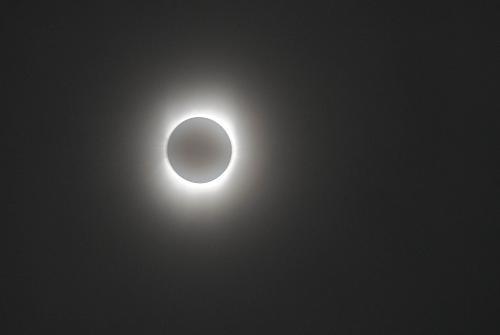A total solar eclipse brought darkness to many places along the upper reaches of China's longest river, the Yangtze, at 9:15 a.m. Wednesday.
The full solar blackout could be seen at 9:30 a.m. from an observatory site in Anji, east China's Zhejiang Province, a site chosen by Jay Pasachoff, head of the Solar Eclipse Working Group of the International Astronomical Union (IAU), and more than 200 astronomers from more than 20 countries.
 |
|
Solar corona in observation site in west China's Chongqing Municipality.
|
"The weather is clear enough to observe the complete duration of the solar eclipse here in Anji. However, the image of the eclipse may not be ideal for professional astronomical analysis, because of the interference of some cloud," said Zhang Hongqi, chief researcher of the National Astronomical Observatories.
He explained that the cloud could affect data collected by astronomical telescope.
"The sky was not perfect," said Pasachoff. "We were very lucky that the clouds got lighter as totality approached...the corona was in the clear area in the sky, so we all got a good deal. It was clearer than other parts in the sky."
"It is the longest solar eclipse that I have watched, " said Martin Stirland, a Briton, who was in a crowd of 2,000 eclipse watchers in Anji.
He said it was the fourth time that he experienced a full solar eclipse, and it was the most beautiful.
The total blackout lasted 5 minutes 38 seconds in Anji.
Many Chinese cities, such as Chongqing and Wuhan in west and central China, turned off many street lights to allow the public to better observe the total eclipse, which lasted about four minutes there.
"This total solar eclipse is just fantastic, you just can't get that feeling from the video or pictures," said Paul Maley, from the U.S. NASA Johnson Space Center Astronomical Society, who watched the eclipse in Wuhan, capital of Hubei Province.
He was accompanied by 40 astronomic amateurs from the United States, Germany and New Zealand to Wuhan for the observation.
The July 22 eclipse is the longest total solar eclipse of the 21st century. It passed across China from Tibet to the coastal city of Shanghai, where 300 million people live.
Millions of eclipse watchers thronged to the banks of the Yellow and Yangtze rivers in northwestern Lanzhou and central Wuhan cities early Wednesday to observe the spectacle.
A partial solar eclipse started at 8:01:27 a.m. in Cona County, Tibet in southwest China, according to an observatory of the Chinese Academy of Sciences (CAS).
The county was one of the first places in the country to see the eclipse.
However, the view at Cona was blocked by clouds, according to sources from the CAS Purple Mountain Observatory based in Nanjing, eastern Jiangsu Province.
Cona is 500 km south of Lhasa, Tibet's capital. The sun was covered by clouds in Lhasa as well on Wednesday.
"It is such a pity. I planned to watch the phenomenon in the plateau city of Lhasa," said Zhou Zheng, a tourist from Beijing.
Instead he saw many Buddhism believers chanting scriptures and walking clockwise around the Potala Palace, since the eclipse coincided with one of the sacred days for the ritual.